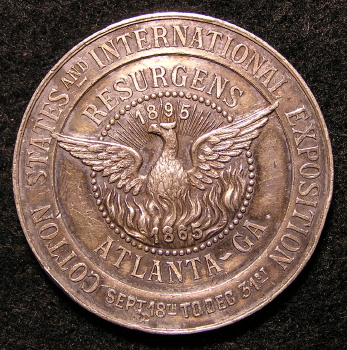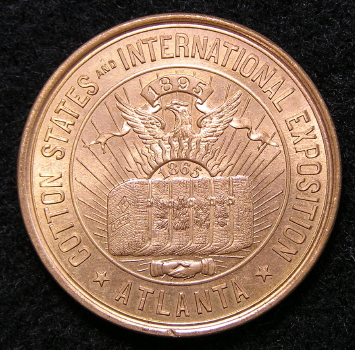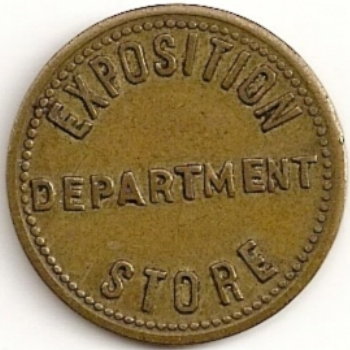Award Medals Issued
– About six thousand exhibits were examined. The Awards Committee awarded a total of 1,573 medals
Gold medals 634 – Silver medals 444 – Bronze medals 495
Observe of the award medal:
The medal features a detailed and dynamic allegorical scene: a classical female figure, possibly representing the personification of Atlanta or the spirit of the exposition, is prominently positioned in the foreground. She is adorned with a crown and holds a staff, signifying leadership and authority. In the background, architectural elements reminiscent of the exposition’s buildings provide context and depth.
The surrounding area is filled with cotton plants, which are a nod to the exposition’s focus on the cotton industry and its significance to the region’s economy. The text “ATLANTA GEORGIA U.S.A.” arcs above the scene, clearly identifying the location and nation of the exposition. The entire composition is framed within a clean, circular border, giving the medal a refined finish.
Reverse Side of the award medal
The reverse side of the award medal from the 1895 Cotton States and International Exposition features a majestic American eagle with outstretched wings, perched atop a pair of crossed cotton bolls and branches, symbolizing the agricultural wealth of the Cotton States. Above the eagle, the inscription “COTTON STATES AND INTERNATIONAL EXPOSITION” is prominently displayed, with the additional designation “AWARDED TO” below, where the recipient’s name would be engraved.
Below the space for the awardee’s name, the text “ATLANTA GEORGIA U.S.A.” along with the date “MDCCCXCV” (1895 in Roman numerals) anchors the medal’s identity to the exposition’s time and place. The border is composed of a dual wreath, likely olive or laurel, signifying peace and victory, adding to the medal’s prestigious appearance.
The reverse’s design elements and the hue of the medal celebrate the success and recognition of the exposition’s participants. This medal embodies the pride and spirit of the event, serving as a lasting tribute to the achievements recognized at this historical gathering.

Gold Medal from the Cotton States and International Exposition, Atlanta GA
634 Issued
57mm diameter. 6mm wide. Gold plated. The medals were executed upon a design prepared under the supervision of Mr. Horace Bradley, Chief of the Department of Fine Arts, and were delivered in the Summer of 1896. It was produced by medallist Peter L. Krider, Philadelphia. His shop excelled at casting, and was one of the largest medal making firms in the country – commissioned to make award medals for the Centennial Exposition in 1876, New Orleans Expo, and Atlanta Cotton States, and others. Gold plated award medal issued to Live Oak Distillery Co. Medal has been gold plated. ANA info.

Gold Medal from the Cotton States and International Exposition
Reverse side of above gold medal.

Silver Medal from the Cotton States and International Exposition, Atlanta GA
57mm diameter, 5mm wide. The most rare of the Atlanta expo award medals, only 444 silver medals were made. Extremely rare, this is the only one of two or three that we have ever seen. This was awarded to Lucy C Andrews. Believed to be silver, not just silver plated.

Silver Medal from the Cotton States and International Exposition, Atlanta GA
Reverse side of above silver medal.

Bronze Medal from the Cotton States and International Exposition, 495 Issued
6mm thick, 57 mm diameter. On Obv ‘Atlanta Georgia USA’, Columbia in long chiton, holding a cornucopia filled with fruit in right arm, standing to left: in front of her, a winged wheel, and a small winged genius bearing a tablet inscribed INDUSTRY; in background to the left is the Fine Arts Building. Singed ‘PH MARTINY SC NY’, this medal is notable as the sole signed work of metallic art by by famous sculpture artist PHILIP MARTINY 1858-1927 whose his baby-like winged cherub has become the emblem of generations. “With it’s exuberant allegorical design and lovely modeling, Martin’s Cotton States Exposition medal exemplifies the high Beaux-Arts style of decorative sculpture.”

Bronze Medal from the Cotton States and International Exposition, Atlanta GA
Reverse side of above medal. The reverse has a palm leaf, the American eagle, a cotton plant and the legend ‘COTTON STATES AND INTERNATIONAL EXPOSITION AWARDED TO WERNER BEHME (who was an inventor) ATLANTA GEORGIA USA MDCCCXCV’.
Souvenir Medals 1895 Atlanta Cotton States Expo

Bird’s Eye View of Cotton States and International Exposition medals signed by Massonnet, Paris.
Silver plated, 2 inch diameter. Reverse BIRD’S EYE VIEW of COTTON STATES AND INTERNATION EXPOSITION, ATLANTA GA. Obverse features the Exposition Seal: rising Phoenix coming form flames and 1895 on top and 1865 on bottom. Around outside COTTON STATES AND INTERNATIONAL EXPOSITION and the dates at bottom SEPT 18TH TO DEC 31ST. Atlanta exposition medal.

Bird’s Eye View of Cotton States and International Exposition medals signed by Massonnet, Paris
Reverse side of above medal. Reverse BIRD’S EYE VIEW of COTTON STATES AND INTERNATION EXPOSITION, ATLANTA GA. Features the birds eye view with Massonnet Editor along right rim. Near bottom OPENS SEPTEMBER 19TH CLOSES DECEMBER 31ST 1895.

Official Souvenir Medal – Henry Grady medal. HK-268 Cotton States so called dollar.
Gilt bronze 34mm. Obverse: Picture of Henry Grady, across the top OFFICIAL SOUVENIR MEDAL and Henry W. Grady across the bottom. Henry Woodfin Grady was a notable journalist and orator from Georgia who became an influential voice in the post-Civil War South. He was a strong advocate for the “New South,” promoting economic diversification away from the reliance on agriculture and advocating for the integration of industry into the Southern economy. Grady’s vision aimed to modernize the South’s economy while reconciling sectional divisions within the United States. As the managing editor of the Atlanta Constitution, he used his platform to champion the cause of Southern progress and unity, and his ideas significantly influenced the region’s development during that period. The medal in his honor, a souvenir from the Cotton States and International Exposition, underscores his importance in the narrative of Southern resurgence and the exposition’s celebration of Southern achievements.

Official Souvenir Medal – Henry Grady medal. HK-268 Cotton States so called dollar.
The reverse side of the Henry Grady official souvenir medal from the 1895 Cotton States and International Exposition features a striking representation of the Great Seal of the United States, showcasing an American bald eagle with its wings spread wide. In its talons, it clutches an olive branch and a bundle of thirteen arrows, symbolizing the nation’s commitment to peace and readiness for war. The eagle is positioned behind a shield adorned with stripes and a banner reading “E PLURIBUS UNUM,” echoing the United States’ motto of “Out of many, one.”
Above the eagle, the dates “1789-1895” are inscribed, indicating the span from the founding of the United States to the year of the exposition. The surrounding inscription “COTTON STATES AND INTERNATIONAL EXPOSITION” along with “ATLANTA” at the bottom, frames the seal, situating this medal within the context of the event. This elegant and patriotic design commemorates both the exposition and the broader narrative of American history and unity, making it a cherished keepsake for attendees and collectors alike.
Liberty Bell at Atlanta Cotton States and International Exposition
In 1895, the Liberty Bell made a patriotic journey to the Atlanta Cotton States and International Exposition, becoming one of the fair’s most celebrated attractions. Its presence was a powerful symbol of America’s enduring spirit of freedom and unity. Transported from Philadelphia to Atlanta for the exposition, the bell’s visit offered attendees a tangible link to the nation’s revolutionary past at a time when the country was looking forward to a future of innovation and progress. This momentous occasion was commemorated by a series of medals featuring the iconic Liberty Bell, serving as cherished keepsakes to remember the fair and the historical significance of the bell’s southern tour.

Liberty Bell Medal – Atlanta Cotton States Expo
Obverse is Bird’s Eye View of exposition with COTTON STATES AND INTERNATIONAL EXPOSITION across the top and Atlanta GA with dates at bottom.

Liberty Bell Medal – Atlanta Cotton States Expo
Reverse has nice large Liberty Bell and across the top the words PROCLAIM LIBERTY THROUGHOUT THE LAND UNTO ALL THE INHABITANS THEREOF. Image provided by Michael at Cherokee Coins, Alpharetta GA
Small Liberty Bell Medals – To Cotton States Exposition Atlanta GA 1895
About dime size in gold, silver and bronze. Obverse has “To Cotton States Exposition Atlanta GA 1895 and on reverse there is a liberty bell with words LIBERTY BELL around top and July 4, 1776 at bottom under bell. Note: the gold, silver medal examples are below.

Gold Colored Small Liberty Bell Medals – To Cotton States Exposition Atlanta GA 1895

Gold Colored Small Liberty Bell Medals – To Cotton States Exposition Atlanta GA 1895
Must be zinc or gold plated

Silver Small Liberty Bell Medals – To Cotton States Exposition Atlanta GA 1895
This sliver medal is just like the gold one above on both sides of the medal. Looks like real silver.
Atlanta Exposition Palace Dollars
The Atlanta Exposition Palace Dollars section highlights a series of commemorative medals that celebrate the architectural grandeur and cultural significance of the 1895 Cotton States and International Exposition. Each medal features a detailed rendering of a key exposition building, serving as a numismatic tribute to the fair’s most iconic structures. Collectors and enthusiasts can appreciate medals depicting “The Administration Building,” “The Women’s Building,” “The Electrical Building,” “Fine Arts Building,” among others. These medals not only honor the architectural achievements of the exposition but also commemorate the spirit of progress and innovation that the event represented. Collectively, they provide a tangible connection to the exposition’s legacy, celebrating its role in shaping the cultural and industrial tapestry of the South at the turn of the century.

Administration Building Medal – 1895 Cotton States Exposition
So-Called Dollar HK-269a in Brass. Also not shown is HK-269 – in Aluminum.

Administration Building Medal Reverse Side – 1895 Cotton States Exposition

Woman’s Building Medal 1895 Atlanta Expo
Aluminum. 37mm. Obverse: Exposition Seal: rising Phoenix coming form flames and 1895 on top and 1865 on bottom. Around outside COTTON STATES AND INTERNATIONAL EXPOSITION and the dates at bottom SEPT 18TH TO DEC 31ST.

Woman’s Building Medal Reverse 1895 Atlanta Exposition
Aluminum. 37mm. Reverse: Edifice; below Woman’s Building; above, around Cotton States and International Exposition; at bottom border, microscopic S. D. Childs & Co. Chicago – HK-271

The Electrical Building Medal 1895 Atlanta Exposition
Aluminum 35mm Observe: Casino and Music Hall, Imitation Battle Ship, Manufactures and Liberal Arts 787 x 1687 Feet, 31 Acres, Cost $1,500,000

The Electrical Building Medal 1895 Atlanta Exposition
Aluminum 35mm Reverse: The Electrical Building, 345 ST WIDE 700 FT LONG, Cost $401,000
Note: this medal really has some interesting details

Fine Arts Building Medal 1895 Atlanta Exposition
Aluminum. 38mm Obv. In center, phoenix, wings outstretched, rises from flames; rays and 1895 above, 1865 in flames below; microscopic Childs below l. and Chi below r. of date–all within circle; within outer rope-like circle and inner circle, at top Resurgens, at bottom Atlanta, Ga., two dots on each side between; wing tips of phoenix extend through second circle; border legend Cotton States and International Exposition Sept 18th to Dec. 31st

Fine Arts Building Medal 1895 Atlanta Exposition
Aluminum. 38mm Rev. Edifice; below Fine Arts Building; above, around Cotton States and International Exposition; at bottom border, microscopic S. D. Childs & Co. Chicago
Frederick Douglass Commemorative Medal
The 1895 Atlanta Cotton States and International Exposition was a significant event, as it was the first to feature a building dedicated to African American achievements, known as the Negro Building. This was a monumental step, as it provided a platform for the celebration and recognition of African American culture and progress.
Frederick Douglass, a towering figure in the fight for civil rights and the abolition of slavery, was to play a prominent role at the exposition. A commemorative medal was struck to honor his participation, featuring his portrait on one side and the Negro Building on the other. Unfortunately, Douglass passed away earlier in the year, on February 20, 1895, and was thus unable to attend the event. His scheduled appearance was highly anticipated, as he was a respected orator and advocate for equality and would have brought significant attention to the achievements and aspirations of African Americans at the time.
Despite his absence, Douglass’s legacy was strongly felt at the exposition. The medal that bears his likeness and the representation of the Negro Building is a testament to his enduring impact. It serves as a reminder of the strides taken towards inclusion and recognition at such national showcases, and the important role Douglass played in the advancement of African American rights. The medal itself is a rare and important artifact, symbolizing a pivotal moment in the history of African American representation in public events and expositions.

Frederick Douglass Commemorative Medal- Atlanta Cotton States and International Exposition Arts Building Medal 1895 Atlanta Exposition
Rare 38 mm aluminum medal from the 1895 Cotton and Industrial Exposition World’s Fair held in Atlanta, Georgia. Labelled Fred Douglas and portrait. The negro building on the reverse.

Frederick Douglas Commemorative Medal- Atlanta Cotton States and International Exposition Arts Building Medal 1895 Atlanta Exposition
Rare 38 mm aluminum medal from the 1895 Cotton and Industrial Exposition World’s Fair held in Atlanta, Georgia. It features the Negro Building on the obverse which was the first African American building in an American Exposition.

Frederick Douglas Commemorative Medal- Bronze
37 mm bronze medal from the 1895 Cotton and Industrial Exposition World’s Fair held in Atlanta, Georgia. Has a relief portrait of Frederick Douglas. Born 1817 Died 1895. Fred Douglass The Greatest Colored Orator and Statesman

Frederick Douglas Commemorative Medal- Bronze
37 mm bronze medal from the 1895 Cotton and Industrial Exposition World’s Fair held in Atlanta, Georgia. features the Negro Building. Colored Race Building medal International Cotton Exposition 1895 Fred Douglass, Sept 18 to Dec 30 1895, Atlanta GA

Small Liberty Head Medal of Atlanta Exposition 1895
Bronze, 1.9mm medal. Lady Liberty circled by stars around edge

Small Liberty Medal of Atlanta Exposition 1895
Bronze, 1.9mm medal. Exposition building. Atlanta Exposition 1895.

Exposition Department Store Token Atlanta Exposition 1895

Exposition Department Store Token Atlanta Exposition 1895
Good For 5 cents In Trade Token
More info from Atlanta History Center About The 1895 Atlanta Cotton States and International Exposition
What was showcased at the The Atlanta Cotton States and International Exposition of 1895?
The Atlanta Cotton States and International Exposition of 1895 was a significant event aimed at promoting the economic recovery of the South following the Civil War and to showcase the technological advancements and cultural progress of the region. Here’s what was showcased, including new products and attractions:
Agricultural Exhibits: Given its name, the exposition highlighted the cotton industry, displaying the latest advancements in cotton processing and agricultural equipment.
Technological Innovations: The fair exhibited new technologies, particularly in the areas of transportation and machinery, reflecting the industrial progress of the South.
The Negro Building: A groundbreaking feature, this was the first building at a Southern exposition dedicated to African American achievements, showcasing art, inventions, and educational advancements.
Electricity: The exposition displayed the wonders of electrical power, including electric lights, which were still a novelty to many.
Cultural Exhibits: There were various cultural and ethnological exhibits, including a replica of a street in Cairo, which offered visitors a glimpse into life in Egypt.
The Liberty Bell: The exposition featured the Liberty Bell, which had traveled from Philadelphia, symbolizing unity and freedom.
New Consumer Products: The fair introduced new products to the public, such as ready-to-eat foods and beverages, reflecting the growth of consumer culture.
Entertainment: There were various forms of entertainment, including musical performances, Wild West shows, and carnival rides, with the Ferris wheel being a prominent attraction.
Education and Social Progress: The exposition included exhibits on education reform, public health, and social services, reflecting the changing landscape of public policy and social welfare.
The Atlanta Cotton States and International Exposition played a crucial role in presenting the South as a region that had recovered from the devastation of the Civil War and was capable of economic and industrial development on par with the rest of the country. It also was a platform to encourage investment and showcase the cultural richness of the South.
What famous and notable people attended The Atlanta Cotton States Exposition?
The Atlanta Cotton States and International Exposition of 1895 attracted several notable figures, including:
Booker T. Washington: His “Atlanta Compromise” speech, where he advocated for African American progress through education and entrepreneurship rather than through confrontation over segregation, was one of the defining moments of the exposition.
W.E.B. Du Bois: While not as widely reported as Washington’s attendance, Du Bois was involved in the planning of the Negro Building and its exhibits.
President Grover Cleveland: He officially opened the exposition via telegraph. This act symbolized the national significance of the event.
Charles W. Macune: A leading organizer of the Farmers’ Alliance and an advocate for rural and agricultural communities, Macune was likely in attendance, considering the exposition’s agricultural focus.
Rebecca Latimer Felton: A writer and women’s rights advocate, she was involved in the exposition’s Woman’s Building.
Henry W. Grady: Although he passed away in 1889, Grady was a significant figure whose ideas of a New South were foundational to the exposition’s themes.
Notable musicians, inventors, and industrialists of the time may have also attended, as the exposition was a significant event for networking and showcasing new technologies and products. It was an event that highlighted the South’s recovery and potential, and thus drew many influential personalities interested in the region’s development.
Other Cotton Expositions and Agricultural Fairs in Atlanta
Also see Georgia medals and tokens, 1881 Atlanta International Cotton Exposition and 1887 Piedmont Exposition Atlanta GA
